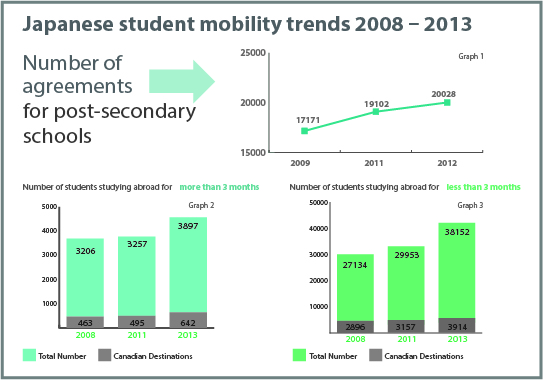International Education trends in Japan
In 2012, the number of Japanese students studying abroad finally returned to positive growth after seven consecutive years of decline.
The Japanese Economy has been recovering since Mr. Shinzo Abe returned as Prime Minister in December 2012 and announced the “Japan Revitalization Strategy” in 2013, which included university reforms and measures to support study abroad. Globalization is a key word. The Ministry of Education, Culture, Sports, Science and Technology (MEXT) is striving to globalize universities and high schools across Japan. Japanese companies are making efforts to hire and develop global human resources to promote further global expansion. The Japanese government wants to develop youth who can contribute to Japan’s global success and competitiveness.
New national goals and initiatives
In 2013, the Japanese Government called for doubling the number of students studying abroad (university students to 120,000; high school students to 60,000) by the year 2020, the year that Tokyo hosts the Olympic and Paralympic games. The Japanese Government allocated 15.3 billion yen (approx. C$153 million) in the 2014 fiscal budget to fund study abroad scholarships, aiming to raise the number post-secondary level scholarship recipients to 32,500 students from 10,200 in the previous year, and high school scholarship recipients to 3,600 from 300.
MEXT has also provided funding this year of 7.7 billion yen (approx. C$77 million) for the Top Global University Project that started in 2014, and 800 million yen (approx. C$8 million) to encourage globalization in 110 schools as part of the Super Global High School Program.
Tobitate Ryugaku Japan is a campaign to promote studying abroad launched by MEXT in 2013. Collecting donations from more than 100 private sector businesses, MEXT has created a new scholarship program under this campaign called the “Public/Private Study Abroad Support System.”
More and more Japanese post secondary students are studying abroad under university exchange agreements. In 2012, there were over 20,000 exchange agreements between Japanese and overseas post secondary institutions. This is 900 more than the previous year. The number of partnership agreements between Canadian and Japanese post-secondary institutions has increased to 560 agreements, up 36 from the previous year. (Graph 1)
Partnership agreements at the secondary school level are increasing as well. In 2014, 2,102 Japanese high schools have overseas agreements, up from 1,909 in 2012.
The number of high school students studying abroad for more than three months increased 20% in two years (from 3,257 students in 2011 to 3,897 students in 2013). For Canadian destinations, they increased almost 30% from 495 to 642 in two years. (Graph 2)
The number of high school students studying abroad for less than three months increased 30% in two years (29,953 students in 2011 to 38,152 students in 2013). For Canadian destinations, they increased 24% from 3,157 to 3,914 in two years. (Graph 3)
Languages Canada reports that 52,823 students enrolled in member programs in BC in 2013, with Japan being the top source country with 9,876 students.
International Education events
- The Ministry of Education and the Ministry of Advanced Education in British Columbia, Canada and MEXT (or Ministry of Education, Culture, Sports, Science and Technology) signed an MOC agreement in June 2015. It was the first partnership agreement between MEXT and a sub-national level of government.
- The first BC offshore school in Japan, Bunka Suginami Canadian International School (Tokyo), opened in April 2015. The opening ceremony was held in June 2015 during the visit to Japan by former Minister of Education Peter Fassbender with about 100 people in attendance, including representatives of the Tokyo Metropolitan Government and MEXT.
- Following the agreement between BCCIE and the Hiroshima Prefectural Board of Education signed in the fall of 2014, agreements have been completed between the Hiroshima BOE and Langley and Richmond School Districts, and teacher training programs have been created at Langara College and Simon Fraser University.
- The Study in Canada Fair organized by the Embassy of Canada to Japan, held each spring and fall, is the largest study abroad event in Japan. At this event, Canadian institutions can reach out directly to potential Japanese students and their parents, as well as local institutional representatives and agents. Last fall, almost 1,900 visitors came and more than 600 meetings took place between Canadian and Japanese institutions and agents at the professional workshop in Tokyo.
- The BC Trade and Investment Office in Tokyo is active throughout the year visiting educational institutions across Japan to meet with educators and students and give presentations on education in BC.
- The BC Trade Office in Tokyo is also pleased to make introductions for BC institutions to Japanese universities, secondary schools, and agencies. Please let us know of your upcoming trips to Japan. We would be pleased to help support your visits.
In summary
Japan’s study abroad market now has the potential to grow in each of the main education sectors: post-secondary, K-12, and languages. I believe that demand by Japanese institutions for partnerships and teacher training will continue to grow offering BC educational institutions opportunity in these areas.
The BC Trade Office in Tokyo is happy to help BC institutions in their work with Japanese institutions. We can arrange small agent workshops, roundtables, or meetings at our office in central Tokyo. We also recommend participating in education fairs to strengthen partnerships with agents, and using the fairs as a platform for “matchmaking,” establishing and maintaining partnerships with Japanese institutions.




